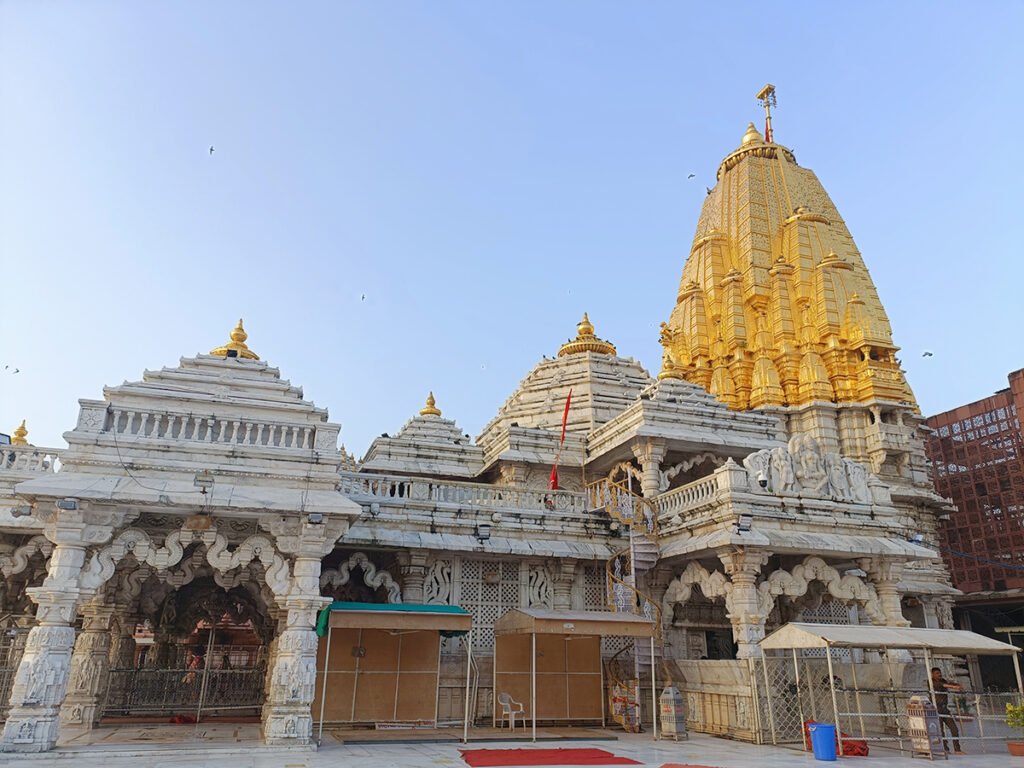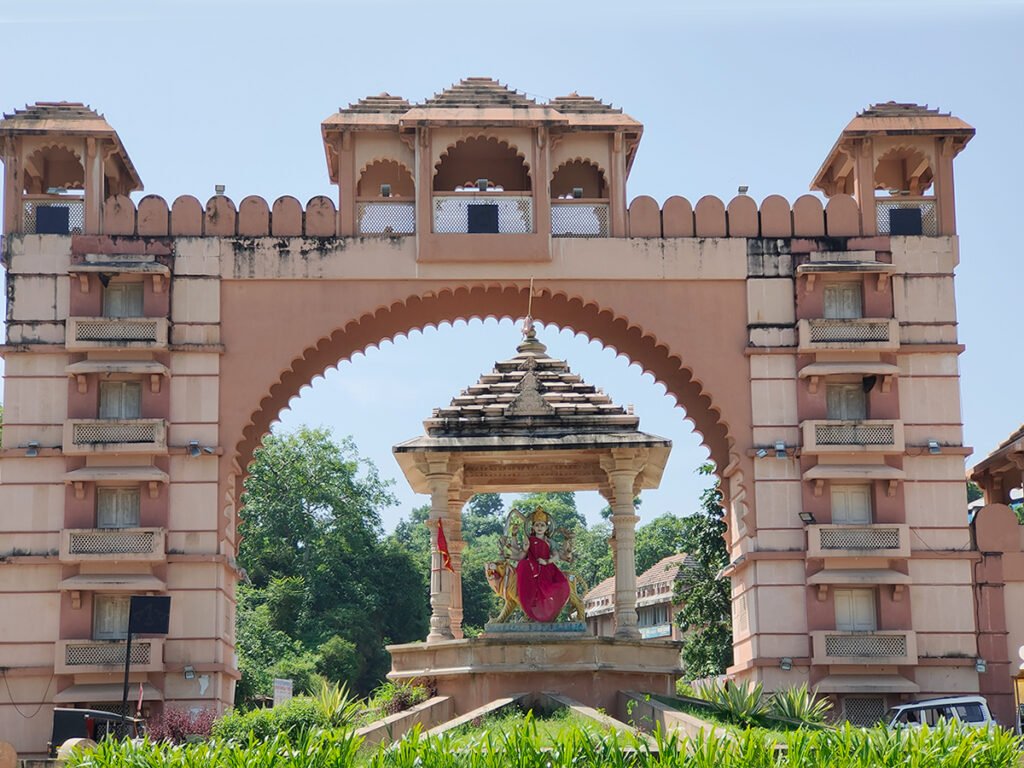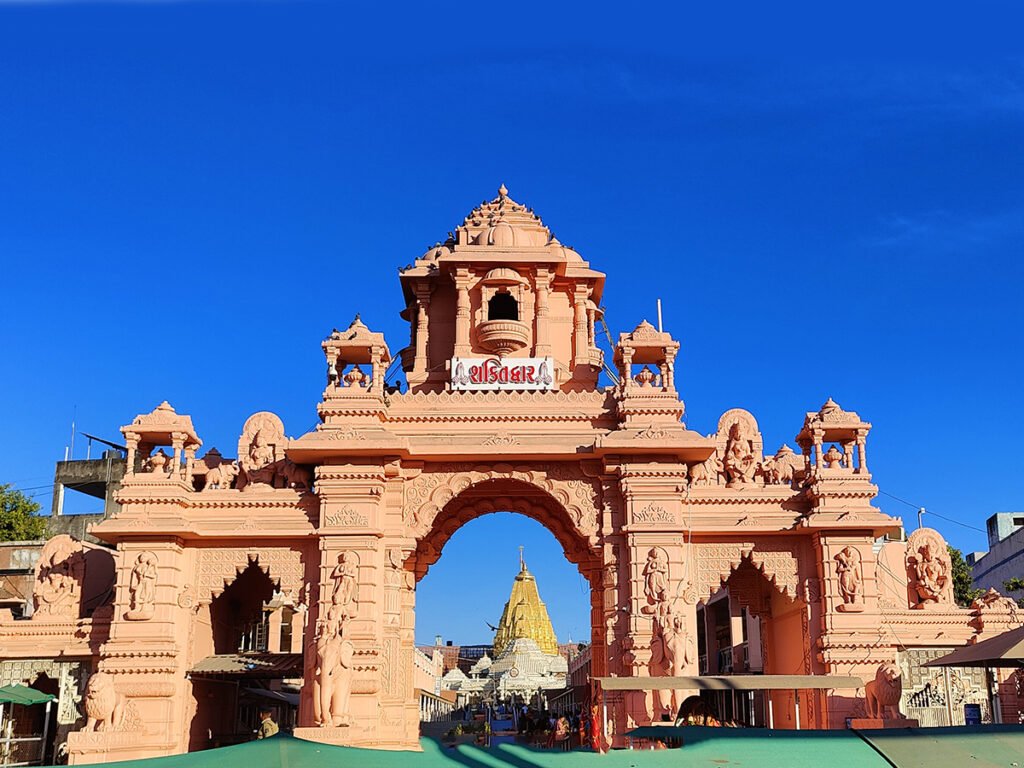Ambaji Temple: The Power of Shakti
Ambaji temple is one of the famous 51 Shakti Peethas located in Banaskantha of North Gujarat. It is located 45 km. from Mount Abu and 185 km. from Ahmedabad city. It is an almost 1200 years old temple and the tip of the temple is 103 feet tall and you have 381 golden Kalash pots installed. Now total mandap is going to get gold plated.

Contents
- 1 Significance of Ambaji Temple:
- 2 History of Ambaji Temple at Banaskantha:
- 3 Speciality of the Ambaji Temple:
- 4 Religious Significance:
- 5 Ambaji Temple Timing:
- 6 Architecture of Ambaji Temple at Banaskantha:
- 7 Places to visit near Ambaji Temple:
- 8 FAQ:
- 8.0.1 Where is Ambaji Temple located in Banaskantha?
- 8.0.2 What is the significance of Ambaji Temple?
- 8.0.3 What is the temple’s history?
- 8.0.4 What is the architecture of the temple like?
- 8.0.5 What are the temple’s visiting hours?
- 8.0.6 Are there any special festivals or rituals at Ambaji Temple?
- 8.0.7 Can non-Hindus visit Ambaji Temple?
- 8.0.8 Is there any accommodation available near Ambaji Temple?
- 8.0.9 How can I reach Ambaji Temple?
- 8.0.10 Is photography allowed in the temple?
- 9 How to reach Ambaji Temple at Banaskantha:
- 10 Google Maps:
Significance of Ambaji Temple:
- According to the mythology Daksha yagna and Sati self-immolation, it is the holy place where “Heart” fell down.
- It is the place where Lord Rama got Shakti to kill the demon Ravan
- Here you don’t have any idol of the goddess Ambaji instead devotees pray goddess in the form of Yantra.
- Devotees throng to the shrine during Purnima (full moon) and a large mela is celebrated on Bhadarvi Poornima (full moon day). On the occasion of Diwali whole temple is lightened which gives the temple a magnificent look.
- It is considered a golden temple of Gujarat.
- It is the place where the hair of Lord Krishna was offered by her mother Yashodha.
If you are planning to visit this shrine to watch goddess Ambaji then you don’t find any idol. Although the goddess is prayed in the form of yantra (gold-plated Shree Visa Yantra), it is kept hidden while performing pooja. Even priests who perform daily rituals close their eyes with a cloth and perform rituals. One can only view yantra with devotion, this yantra is prohibited from photography. It is believed that the original seat of the goddess is on Gabbar hilltop.
Bhog nivedan is prepared at the temple premises only where they use desi ghee and wood to prepare. Goddess Ambaji is decorated three times a day.
Explore More Temples>> Jwala Ji Temple Jwalamukhi Kangra
History of Ambaji Temple at Banaskantha:
The history of the Ambaji Temple is a long and complex one, dating back to the pre-Vedic period. The temple is believed to have been built by the Yadavas, a Hindu tribe, in the 7th century CE. However, there is also evidence to suggest that the temple was in existence even earlier.
In Hindu mythology, the heart of Sati Devi, the first wife of Shiva, fell at this site after she immolated herself in protest of her father Daksha’s disrespect towards her husband. The temple is believed to be the place where Sati’s heart was reunited with her body.
The temple has been destroyed and rebuilt several times over the centuries. The current structure was built in the 19th century by the British.
Explore More Temples>> Shri Devikoop Bhadrakali Temple

Speciality of the Ambaji Temple:
The Ambaji Temple is unique in that it has no idol of the goddess in the sanctum sanctorum. Instead, the goddess is worshipped in the form of a Shri Yantra, a sacred geometric diagram.
The Shri Yantra is a symbol of the divine feminine energy. It is believed to contain the essence of the goddess and to be a source of power and protection.
Religious Significance:
The Ambaji Temple is one of the most important pilgrimage sites in Hinduism. It is a major center of worship for the Shakta sect, which worships the goddess Shakti.
The temple is also a popular destination for Hindus from all over India. The annual Navratri festival is a major event at the temple, attracting millions of devotees.
Explore More Temples>> Bajreshwari Devi Temple Kangra
Ambaji Temple Timing:
Ambaji Temple is open for darshan all seven days of the week. The visiting hours are:
- Morning: 7:00 AM to 11:30 AM
- Afternoon: 12:30 PM to 4:30 PM
- Evening: 6:30 PM to 9:00 PM
Architecture of Ambaji Temple at Banaskantha:
Main Temple Structure: The main temple structure is built in the Nagara style of architecture, which is typical of North Indian temples. It consists of a sanctum sanctorum (garbhagriha) where the deity is enshrined, and a tower or shikhara rising above it.
Shikhara (Tower): The shikhara is a prominent and ornate feature of the temple. It typically rises to a considerable height and is adorned with intricate carvings and sculptures. It is designed to be visually striking and symbolizes the peak or abode of the deity.
Garbhagriha: This is the innermost sanctum of the temple where the idol of Goddess Ambaji is placed. It is a sacred space where devotees offer their prayers and worship.
Mandapa: The temple complex often includes a mandapa, which is a covered hall used for various rituals, ceremonies, and as a gathering place for devotees. The mandapa may have pillars and elaborate carvings.
Entrance and Gopuram: The temple typically has an impressive entrance, and in some cases, a gopuram, which is a monumental and ornate tower-like gateway with intricate sculptural details.
Sculptures and Artwork: The Ambaji Temple is known for its intricate and detailed sculptures and artwork that depict various mythological stories, deities, and symbols. These carvings can be found on the temple walls, pillars, and ceilings.
Decorative Elements: The temple is adorned with decorative elements such as spires, domes, and finials, often covered in gold or other metals. These elements add to the temple’s grandeur and beauty.
Prakara (Enclosure): The temple complex is often enclosed by a wall, creating a sacred space for devotees to circumambulate or walk around the main temple.
Yagna Kund (Fire Pit): Many Hindu temples have a yagna kund where sacred fire rituals and offerings are made.
Overall Aesthetic: The architecture of the Ambaji Temple, like many Hindu temples, is designed to create a sense of awe, devotion, and spiritual experience for the devotees. The use of symmetry, sacred geometry, and carefully chosen materials all contribute to the temple’s aesthetic appeal.

Places to visit near Ambaji Temple:
Kamakshi Mandir: This temple is dedicated to the goddess Kamakshi and is located near the Ambaji Temple. It’s worth visiting for its unique architecture and religious importance.
Gabbar Hill: The Gabbar Hill is a sacred hill located about 4 km from the Ambaji Temple. You can climb the steps to reach the temple at the hilltop and enjoy panoramic views of the surrounding region. This is a popular spot for devotees and tourists alike.
Kailash Hill Sunset Point: This is another scenic spot where you can enjoy the breathtaking views of the sun setting behind the hills. It’s an ideal place for some peaceful moments and photography.
Kumbhariya Naka: This area is known for its bustling local market. You can shop for traditional Gujarati textiles, handicrafts, and other souvenirs. Don’t forget to taste the local street food.
Balaram Palace Resort: If you’re looking for a luxurious stay, consider the Balaram Palace Resort. It’s a beautiful heritage hotel that used to be the hunting lodge of the princely state of Balasinor. The architecture and surroundings are exquisite.
Kailash Tekari: This is a serene and peaceful temple dedicated to Lord Shiva. It’s a great place for meditation and seeking spiritual solace.
Mangalya Van: It’s a well-maintained garden and park where you can take a leisurely walk or spend time amidst the lush greenery.
Shri Koteshwar Mahadev Temple: Located about 8 km from Ambaji, this temple is dedicated to Lord Shiva and is situated in a cave. It’s known for its spiritual and natural beauty.
Banaskantha District: Explore the natural beauty and rural life of the Banaskantha district. The region offers picturesque landscapes, farms, and a glimpse into the rural culture of Gujarat.
FAQ:
Where is Ambaji Temple located in Banaskantha?
Ambaji Temple is situated in the town of Ambaji in the Banaskantha district of Gujarat, India.
What is the significance of Ambaji Temple?
Ambaji Temple is one of the 51 Shakti Peethas, which are sacred shrines dedicated to the goddess Shakti. It is believed to be the source of the cosmic power and is a place of immense religious significance for Hindus.
What is the temple’s history?
The exact history of Ambaji Temple is not well-documented, but it is believed to be an ancient temple with roots dating back centuries.
What is the architecture of the temple like?
The temple features a stunning and traditional Hindu architectural style. It is characterized by intricate carvings and beautiful design elements. The inner sanctum houses the idol of the goddess Amba, which is a significant attraction.
What are the temple’s visiting hours?
The temple is generally open to visitors from early morning until late in the evening. However, specific visiting hours may vary, so it’s a good idea to check with the temple authorities for the most accurate and up-to-date information.
Are there any special festivals or rituals at Ambaji Temple?
The temple celebrates several festivals throughout the year, with Navaratri being one of the most significant. During Navaratri, the temple attracts a large number of devotees who come to worship the goddess.
Can non-Hindus visit Ambaji Temple?
Non-Hindus are generally allowed to visit Ambaji Temple, but it’s important to be respectful of the temple’s customs and traditions. Dress modestly and follow the rules and guidelines set by the temple authorities.
Is there any accommodation available near Ambaji Temple?
Yes, there are various accommodation options available in the town of Ambaji and the surrounding areas to suit different budgets. Many hotels and lodges provide a comfortable stay for pilgrims and tourists.
How can I reach Ambaji Temple?
Ambaji is well-connected by road, and it is easily accessible from various cities and towns in Gujarat. The nearest railway station is at Abu Road, which is about 20 kilometers away. The nearest airport is in Ahmedabad, which is approximately 180 kilometers from Ambaji.
Is photography allowed in the temple?
Photography rules may vary, so it’s best to ask the temple authorities about their policies regarding photography and videography within the temple premises.
How to reach Ambaji Temple at Banaskantha:
- By Air: The nearest airport to Ambaji is the Ahmedabad Airport (Sardar Vallabhbhai Patel International Airport). From there, you can hire a taxi or take a bus to Ambaji, which is approximately a 3-4 hour drive.
- By Train: The nearest railway station to Ambaji is Abu Road Railway Station, which is approximately 20 kilometers away. You can take a train to Abu Road from major cities like Ahmedabad, Delhi, Mumbai, and Jaipur, and then hire a taxi or take a local bus to Ambaji.
- By Road: Ambaji is well-connected by road. You can reach Ambaji by bus or car:
- From Ahmedabad: Ambaji is around 180-200 kilometers from Ahmedabad. You can take a bus from Ahmedabad Central Bus Station or hire a taxi to reach Ambaji.
- From Mount Abu: If you’re coming from Mount Abu, it’s about 45 kilometers to Ambaji. You can hire a taxi or take a local bus.
- From other nearby cities: Ambaji is well-connected by road to nearby cities like Palanpur, Abu Road, and Himatnagar. You can find bus services to Ambaji from these cities.
- Local Transportation: Once you arrive in Ambaji, you can hire a taxi or an auto-rickshaw to reach the Ambaji Temple. It’s a short ride from the main bus stand or railway station to the temple.
